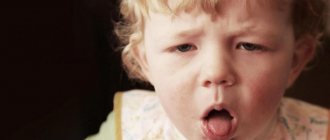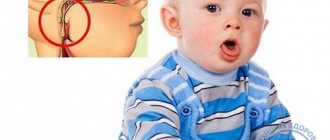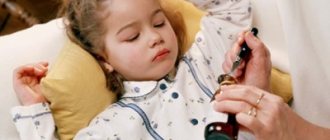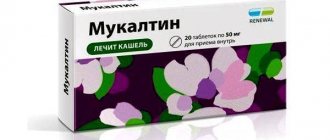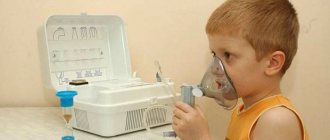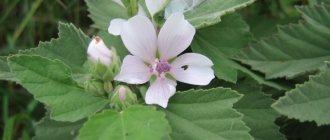The most difficult test for parents of a baby is a sick child. Especially if the disease is accompanied by attacks of intense coughing, reminiscent of a dog barking. In this article, we will consider what provokes a barking cough in a baby, why this reflex is dangerous, and what measures should be taken to eliminate it.
Reasons for appearance
Coughing is a protective reflex, which is a forced exhalation through the oral cavity, causing muscle contraction of the airways due to irritation of the receptors. The physiological purpose of a cough is to clear the respiratory tract of sputum, mucus and other irritating agents, as well as foreign bodies (food debris, small objects, etc.).
Depending on the nature and amount of discharge, a distinction is made between dry (non-productive) and wet (productive) cough. Children (usually between four months and three years old) often suffer from a dry, paroxysmal cough accompanied by sounds similar to a barking dog. This led to the name of the disease - barking cough.
Typically, this symptom accompanies viral pathologies of the upper/lower respiratory tract. A nonproductive cough is the result of inflammatory processes in the nasopharynx, larynx, trachea, bronchi or lungs. Since the baby’s respiratory organs are still imperfect - a narrow larynx, the entry of an infectious agent provokes swelling and inflammation, as a result of which thickening/swelling of the mucous membrane of the trachea and larynx is observed, leading to an even greater narrowing of the lumen of the respiratory tract.
As a result, breathing becomes difficult. In addition, the body, in an attempt to cope with the virus, releases exudate, further preventing the free passage of air. The receptors in the mucous membranes are irritated, which leads to a barking cough, hoarseness, nasal congestion, and increased body temperature (this symptom may not appear).
As a child grows, the lungs and airways develop. Dry cough appears less frequently.
How dangerous is the condition?
A barking cough occurs when there are problems with breathing. Due to the narrow lumen that accompanies swelling of the throat, pharynx and vocal cords, whistling sounds appear and the voice becomes hoarse. The child inhales convulsively and exhales with difficulty. You need to act quickly if the skin in the nasolabial triangle area turns blue.
Complications and consequences
Nervous cough in a child—symptoms, treatment
If a baby suffering from a barking cough is not helped in time, the swelling will cause the gap to begin to narrow and the baby will not have enough air. Because of this, he may lose consciousness. Lack of oxygen disrupts the functioning of the body, which leads to irreparable consequences.
Note! It is better not to make you faint; if you experience shortness of breath or a hoarse voice, call a doctor or an ambulance. Severe inflammation can lead to suffocation.
A barking cough can lead to asthma. The disease will become chronic, and the baby will periodically suffer from attacks.
Barking cough without fever: causes
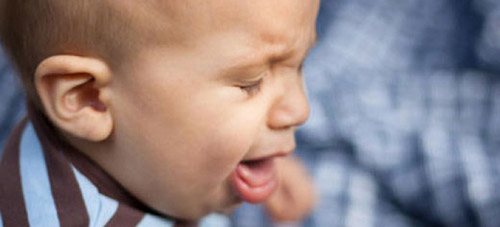
There are often cases when a dry cough appears, but other symptoms of the disease are not observed. Body temperature remains normal. In this case, we are talking about a non-infectious cough. Experts name the following reasons that provoke it.
Foreign bodies entering the respiratory tract
These could be: small toy parts, leftover food, pieces of bread. You should not give your baby small objects to play with, and it is also important to carefully ensure that there are no toys with small parts that can easily separate in the room or crib.
Symptoms depend on the size of the foreign body. A small object makes itself known by bouts of barking cough, sometimes with the appearance of purulent sputum, and difficulty breathing. In this case, you need to immediately turn the child onto his stomach and tap him on the back with the edge of your palm.
Large foreign bodies cause severe fear, blueness of the face, and wheezing. The baby becomes restless, rushes about, and within 2-3 minutes may fall into a coma. If not treated promptly, this can lead to death.
Allergic reaction
The body of a small child is characterized by increased sensitivity to external stimuli. An allergen can be animal fur, flowering plants, food, polluted air, cigarette smoke.
Dry air
Increased dryness of the air can also cause attacks of dry cough. Therefore, you need to regularly monitor this: ventilate the room, carry out wet cleaning of the room, and, if necessary, purchase an air humidifier.
Physiology
An infant under one year of age may develop a physiological cough caused by natural causes: it clears the airways. Neonatologists claim that such a useful reflex can be observed in infants up to 15-20 times a day. This is normal.
If a paroxysmal barking cough appears in children, immediate consultation with a doctor is indicated. Based on an examination and, if necessary, laboratory tests, the pediatrician will determine the cause of this symptom and prescribe appropriate treatment.
Symptoms and diagnosis of barking cough in a child
Many parents cannot determine what contractions of the pectoral muscles are occurring in their children. A barking cough can be diagnosed by a sharp, paroxysmal exhalation, reminiscent of the sound made by a dog. At the same time, the body tries to balance the deterioration of the condition by taking large, deep breaths, and the child opens his mouth wide and sticks out his tongue a little.
If the symptoms of the disease do not raise doubts about its cause (viruses, infections), then treatment can be carried out at home. It is necessary to seek help from a hospital if the following manifestations of a pathological condition appear:
- dry, unproductive cough does not go away even after taking special medications;
- the patient's body temperature rose sharply (over 38°C);
- the child is hoarse or cannot speak at all;
- shortness of breath appeared, complexion changed (pallor);
- breathing is difficult, wheezing.
With such symptoms, you must immediately call an ambulance and do not refuse hospitalization.

You can determine the causes of a barking cough in a child by performing hardware diagnostics. For severe cramps that last several days, the doctor recommends x-rays, magnetic resonance imaging, and computed tomography to exclude oncology, tuberculosis and pneumonia.
Major diseases accompanied by barking cough
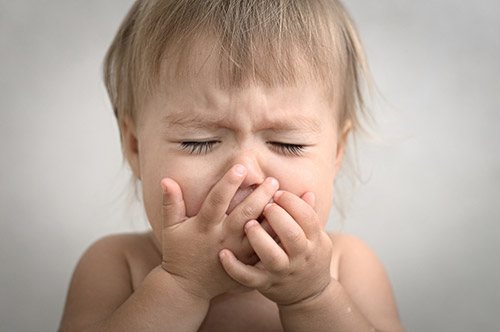
A barking cough in a child is most often a symptom of some kind of respiratory disease. Let's take a closer look at what diseases provoke a nonproductive cough.
Laryngitis
Laryngitis - inflammation of the mucous membrane of the larynx - is a common pathology in children under 3 years old, associated with the anatomical features of the body.
Provocateurs - viruses and allergens, as well as genetic predisposition, incorrect use of the spray, unstable psycho-emotional state
The pathology manifests itself suddenly: at night, a healthy child is attacked by frequent bouts of barking cough, accompanied by wheezing in the upper respiratory system. Breathing is shallow, the child's temperature rises.
Pharyngitis
Pharyngitis is an inflammatory process of the laryngeal mucosa and lymphoid tissue caused by pathogenic microorganisms. Other diseases can provoke and activate pathology, for example, caries, inflammation of the nasopharynx, and allergies.
It is accompanied by a strong sore throat, against which a barking cough appears after a while. In infants, pharyngitis leads to swelling of the mucous membrane, spasms and suffocation.
OSLT is acute stenosing laryngotracheitis, or so-called false croup, which occurs against the background of a viral infection. Children who have previously suffered from neurodermatitis, allergies, and diathesis are more susceptible to this pathology.
Laryngeal stenosis manifests itself with a dry barking cough, hoarseness of voice (may disappear altogether), and febrile temperature.
Influenza, ARVI, adenoviruses
These pathologies of viral etiology are accompanied by the following signs:
- hyperthermia;
- pale skin;
- frequent (exhausting) non-productive barking cough;
- breathing accompanied by whistling (especially when inhaling);
- hoarseness;
- attacks of suffocation at night.
Diphtheria
Diphtheria is an acute infection caused by the diphtheria bacillus. It is transmitted by airborne droplets, as well as through household items, and is characterized by a severe course.
Foci of infection occur in the oropharynx, on the skin, eyes, genitals, and ears.
From the age of 3 months, children receive preventive vaccinations.
Diphtheria is characterized by an acute onset: a sharp increase in temperature, pain in the throat, the formation of a gray-yellow coating on the tonsils with clear boundaries, and enlarged lymph nodes.
In children, the pathology is dangerous due to the development of true croup. Its first signs are a barking cough and whistling breathing. If assistance is not provided in a timely manner, asphyxia (suffocation) may occur.
Whooping cough
Whooping cough is an infection caused by the bacterium Bordetella pertussis. Affects the mucous membranes of the respiratory tract.
Infection occurs through airborne droplets upon contact with a carrier of the virus.
A strong non-productive barking cough, often ending in vomiting and accompanied by hemorrhage into the mucous membranes, is the first sign of pathology. The pathology is also accompanied by severe headaches and mucus discharge from the sinuses.
Asthma
Bronchial asthma is a chronic pathology characterized by bronchospasm. Occurs against the background of allergies.
Asthma is accompanied by a dry barking cough, wheezing, and severe attacks of suffocation.
A paroxysmal barking cough can appear due to developmental defects of the respiratory system, pathologies of the cardiovascular and digestive systems, the formation of tumors in the respiratory organs, disorders of the nervous system, burns, and helminthic infestations.
Causes
Doctors often say a wise phrase: “It is not the cough that needs to be treated, but its causes.” Most often, this symptom occurs in children from four months to five years of age. For a one-year-old child, it is not uncommon for the baby to cough heavily, and this is a manifestation of acute laryngitis during a viral infection.
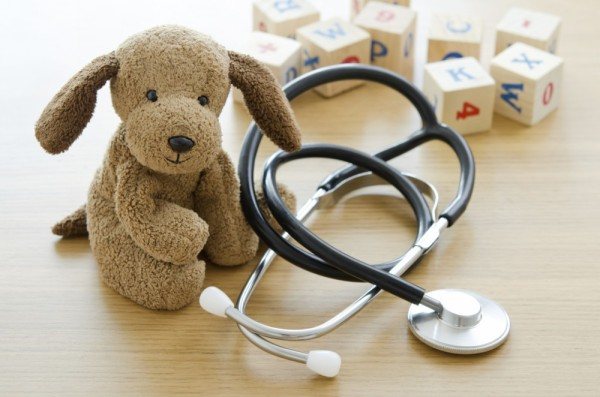
Usually, a one-year-old baby is no longer put to the breast, maternal immunity in children disappears, and they become more vulnerable to all kinds of infections. The reason is that children are characterized by a narrow larynx, and exposure to microbes (bacteria or viruses) causes inflammation and swelling of its mucous membrane.
Harmful microorganisms enter the child's respiratory tract, causing inflammation of the tissues, followed by swelling and the release of exudate. As a result, in children the laryngeal lumen decreases and there is insufficient air supply to the lungs. The child’s cough receptors are irritated, the muscles of the lungs, bronchi and chest reflexively contract, and a cough begins.
- Interesting read: diagnosis and treatment of parawhooping cough
Coughing itself is a useful reflex, since its key role is to clear the airways of bacteria and mucous contents and improve the breathing process.
This happens if children have a wet cough with sputum production. But a child’s dry, barking cough, often at night, does not bring relief to the patient, but only depletes and exhausts his strength.
In an infant, a strong barking cough is often a defensive reaction as a result of debris or dust particles getting into the respiratory organs, which does not pose a danger, and in this case the child does not need to be treated.
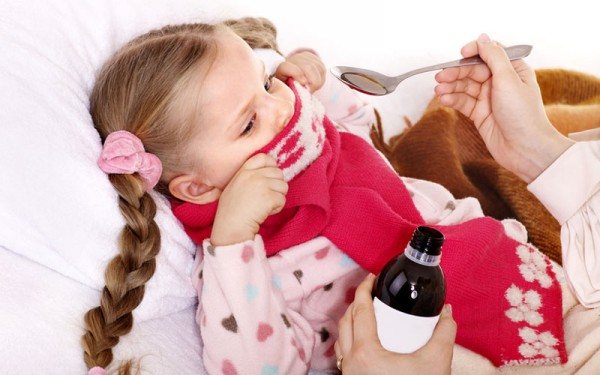
At the same time, if an infant suddenly begins to have a paroxysmal cough, this may indicate that a foreign object has entered the baby’s respiratory system. Also, a similar symptom in an infant can be caused by too dry air, the smell of tobacco or another strong odor.
Why is a barking cough dangerous?
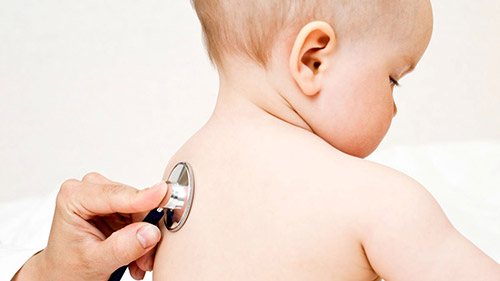
Readers of Ogrudnichke.ru recommend: - Review of the most popular vitamin supplements for children from Garden of Life Read the article >>> - How can Earth Mama products help young parents care for their infants? Read the article - Dong Quai is an amazing plant that helps maintain youth in the female body Read more... - Vitamin complexes, probiotics, omega-3 from Garden of Life, designed specifically for pregnant women Find out more >>>
A dry cough is, first of all, dangerous because inseparable sputum accumulates in the lungs and the infection is not cleared from them. This condition can lead to serious consequences.
A barking cough can be a sign of a serious condition that can be fatal. Immediate medical attention is needed if your child develops a dry cough and a number of other symptoms:
- breathing accompanied by wheezing;
- severely irritated throat;
- fainting, lethargy;
- difficulty breathing, swallowing, speaking (attacks of suffocation);
- excessive salivation;
- cyanosis - blueness of the skin, lips, nails;
- muscle weakness;
- purulent and bloody discharge when coughing;
- hoarseness or loss of voice;
- resistance to treatment.
An immediate visit to a pediatrician to determine the true cause of the cough and timely, systematic treatment will prevent the development of complications. Severe consequences of a long-term nonproductive cough can include pneumothorax, laryngeal stenosis, occlusion, and even death caused by respiratory arrest.
Basic principles of treatment
Self-medication of a barking cough in a newborn is unacceptable. When this protective reflex appears in a baby, you should definitely seek advice from a pediatrician, since it can be physiological (an indicator of normality), as well as evidence of the development of a serious pathology.
However, parents can alleviate the baby’s condition when a dry cough appears. To do this, you must use the following recommendations from experts;
- Regular (at least twice a day) ventilation of the room and maintaining the air temperature within 20-22 degrees Celsius.
- Maintaining an optimal level of humidity (especially during the heating season) using a humidifier or improvised means. For example, placing containers of water on the radiator, hanging wet sheets, spraying with a spray bottle.
- Compliance with drinking regime. To prevent dehydration, you need to give your baby something to drink often (especially if the body temperature is high). It is worth giving preference to drinking water, juices, fruit drinks, and herbal tea.
- Regular walks in the fresh air are beneficial as they help open the lungs.
- Light massage stroking the back will help improve sputum separation.
- Inhalation with a nebulizer in the absence of fever. Saline solution (5 ml) is ideal as a solution for inhalation. Inhaling saline will moisten the mucous membranes of the respiratory tract and reduce the viscosity of sputum.
If a barking cough is accompanied by a febrile temperature, the child is usually hospitalized and prescribed drug therapy.
Prevention of cough
- Maintain a normal level of humidity in the room. You can use a humidifier or place a container of water next to the heating device, which helps dust settle quickly. You can hang wet towels in the room.
- Ventilation of the room.
- Frequent, long walks in the fresh air.
- It is also advisable to maintain the temperature in the room around 20 degrees. The warmer the room, the less clothing the child should wear.
- New things, plants, and objects with a strong smell should be removed from the room.
Coughing is a protective reflex of the body. The more often a child coughs, the faster germs are eliminated. If the cough does not decrease after a few days, you should resort to medication. Their use should be under the strict supervision of a doctor who prescribes the dosage and duration of treatment.
Medicines
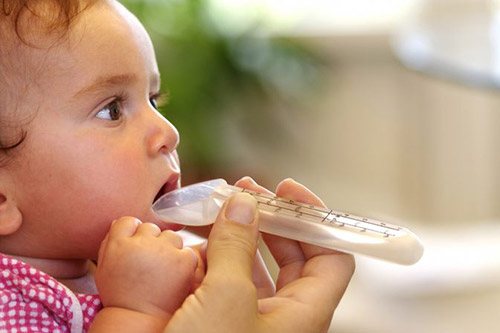
What medications can be used to treat barking cough in an infant? This question is of great concern to the parents of the baby, since at this age the list of acceptable medications is limited.
Pediatricians mainly prescribe drops and syrups to infants as the safest and most convenient form of medication.
When treating barking cough in a newborn, the following groups of medications are used.
Antitussives
Designed to suppress the cough reflex, they are excellent for combating paroxysmal, obsessive, unproductive coughs. From the age of two months you can use Sinekod. The dosage depends on the child's weight. The medicine is taken under medical supervision.
Mucolytic drugs
Prescribed to thin viscous mucus in the respiratory tract. The main active ingredients of mucolytics are ambroxol, acetylcysteine, bromhexine. Frequently prescribed syrups include Ambrobene, Lazolvan, Flavamed, Abrol, Mukolic, Fluditek and others.
Expectorants
Used after the cough has subsided and sputum has been released. These drugs help cough up sticky mucus. For children under one year of age, plant syrups made from extracts of ivy and plantain, as well as marshmallow, anise, licorice, thyme, thyme, coltsfoot and others are used. The most famous herbal cough syrups are Pectolvan Ivy, Prospan, Gedelix, Alteika, Linkas, etc.
The above medications can be given to the baby only in the dosage prescribed by the doctor. You cannot increase the dose on your own. It is also unacceptable to take expectorants and antitussives at the same time, since this combination is dangerous.
Folk remedies
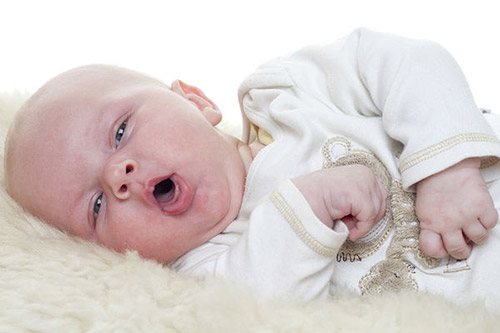
It is not advisable to treat a barking cough in a newborn with folk remedies. Alcohol, vinegar and mustard compresses are contraindicated for up to a year, as they can cause burns and allergies in the form of urticaria and bronchospasms. The use of multicomponent herbal preparations is not permitted.
If the cough reflex is accompanied by redness of the throat, you can give the baby a chamomile decoction. It is allowed to buy ready-made sachets, as well as prepare the decoction yourself. For this, 1 tsp. pour a glass of boiling water over the flowers, leave for half an hour, filter and give 2-3 teaspoons up to 6 times a day.
A procedure such as drainage massage is great for dry coughs. It can be performed at home. The technique is as follows:
- place the baby tummy down on your lap so that the head is lower than the body;
- stroke the back with circular movements, avoiding the spine area;
- Use the edge of your palm to perform intense pats and taps, moving from the lower back to the shoulder blades;
- After repeating the tapping several times, place the child upright so that he has the opportunity to clear his throat.
You can repeat the drainage massage several times a day.
What is a barking cough
A barking cough is a type of dry cough. It is characterized as useless due to the fact that air is coughed up, but no phlegm comes out. Because of this, the airways are not cleared, and painful sensations may occur during coughing. With this type of cough, the child's mouth is wide open and the tongue is completely protruded. Because of these features, it resembles a bark.
A barking cough in an adult, in many cases, manifests itself in a more restrained manner, but the causes and symptoms differ minimally.
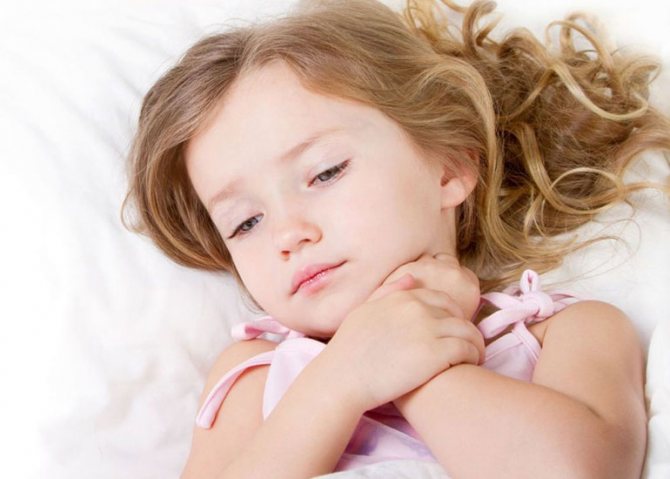
Worsening of health with barking cough
Preventive actions
Preventative measures that parents should follow will help prevent the occurrence of colds and bouts of barking cough in infants:
- Hardening procedures. It is advisable to accustom a child to them from the first days of life. Water procedures and air baths are considered the most effective. Walks in the fresh air should be daily, and in warm weather - repeated. The main thing is not to overheat the baby: try to choose clothes correctly. Pouring your feet with cool water every day has a good effect. In the summer, allow your baby to walk barefoot. In winter, the following procedure is useful: soak a towel in a saline solution (1 liter of warm water per 1 tablespoon of salt), wring it out well, spread it on the floor and let the baby (with your help) walk on the towel. After this, rub your feet - this stimulates the immune system.
- Do not smoke in the presence of a child; tobacco smoke can cause allergies.
- If you have an allergic cough, avoid contact with irritants.
- Avoid visiting crowded places during viral epidemics.
- Strengthen your immune system. The domestic drug Derinat will help with this, promoting the production of its own interferons that suppress pathogenic microflora. It can be dripped into the nose from the first days of a baby’s life. The action of Interferon and Laferbion is similar.
- Monitor the baby’s nutrition, and when breastfeeding, the mother’s nutrition. It should be complete, enriched with vitamins. It is allowed to take a multivitamin course.
Remember that only a doctor can prescribe the dosage and method of using cough medications for an infant. Self-prescription (especially folk remedies) is unacceptable, as it can provoke an allergic reaction and cause complications.
Advice from Dr. Komarovsky

Famous Dr. E.O. Komarovsky is convinced that when a cough reflex appears in a child, it is not the cough that should be treated, but the reason that prompted it. Until the cause of the cough reflex is eliminated, it will not go away.
Therefore, the main task of parents is to identify the cause and create conditions that ensure the elimination of cough. For physiological reasons, increase air humidity; for allergic reactions, reduce the reaction to the allergen; for viral ones, wait for the body to form antiviral immunity.
E.O. Komarovsky allows the use of medications, but on the condition that the prescription was made by a specialist - a pediatrician. Therefore, he advises a clear division of roles: the doctor must look for and eliminate the cause of the cough, identifying conditions when it is impossible to do without medications, and parents must create conditions for the body to effectively fight cough and the action of medications.
Parents should remember that the fight against barking cough must be comprehensive: medications will not be effective if the room is not ventilated, the humidity level is not controlled, and the drinking regime and other recommendations given in this article are not followed.
Folk remedies for cough
You can try to cure the child yourself, but such methods are used either in conjunction with drug therapy or in the first stages of the disease.
If the cough is barking and deep, there is no fever, then you can prepare a mixture for a compress. The main ingredients are honey, mustard, vegetable oil and flour. Mix everything thoroughly, pour the contents into the frying pan and bring to a boil. After this, transfer the mixture to gauze or a clean cloth. Place on the baby's chest or back. Cover with a warm towel on top.
Older children (about 8 months) can be treated with salt. It is heated in a frying pan, poured into a bag and applied to the chest or back. You need to tie a warm scarf on top. As soon as the salt has cooled, the bag is removed and the scarf is left to further retain heat.
Baths with eucalyptus. If the child feels well and there is no fever, then you can take a bath. Add a few drops of extract to the water. The cough becomes moist after several such techniques.
You can massage with honey. To do this, apply a little honey to the chest and massage it until completely rubbed in. After this, the child is wrapped up.
Tea with chamomile or coltsfoot can be drunk by children from two months, but provided that there is no individual intolerance to the components. Respiratory problems can also be treated with steam inhalation. They must be done with caution, as you can burn the mucous membrane.


